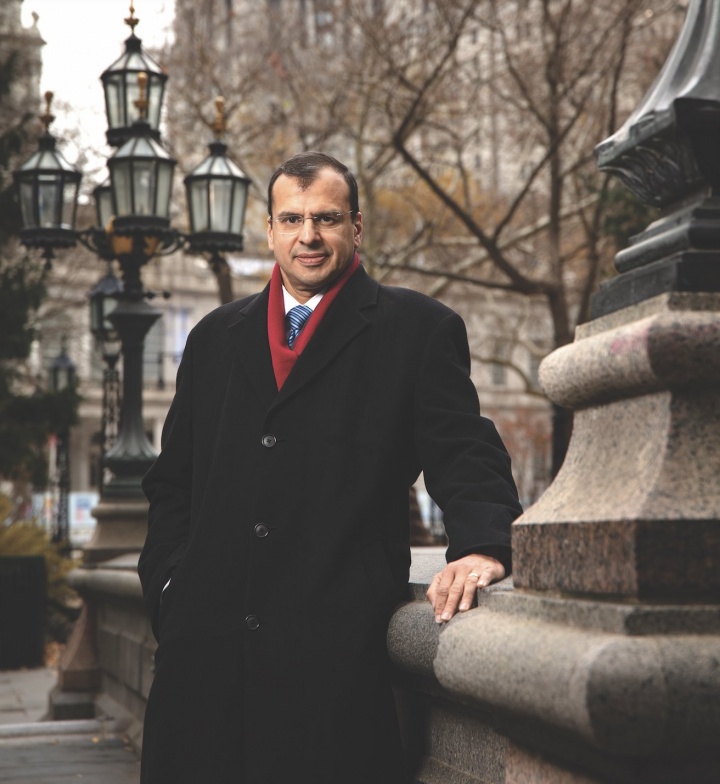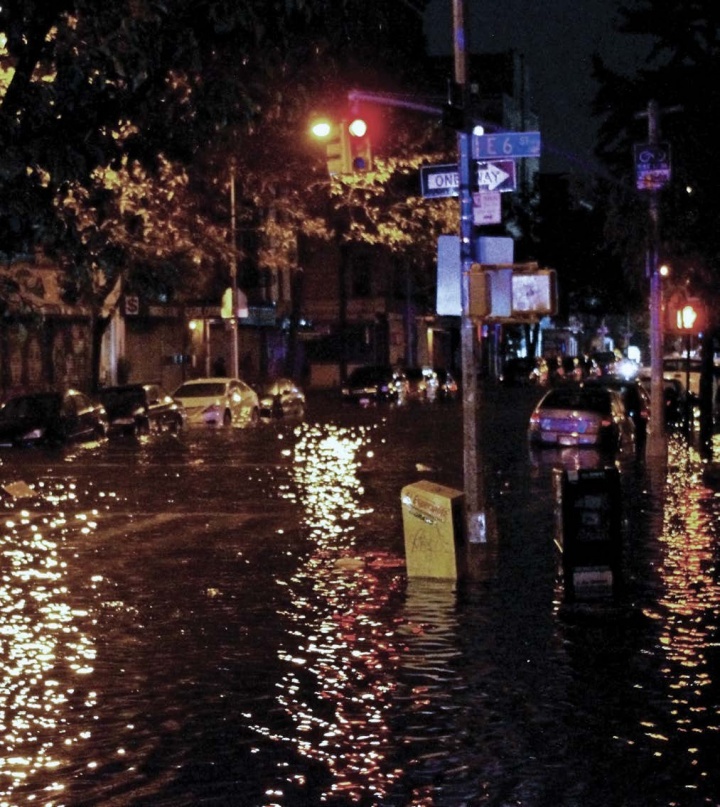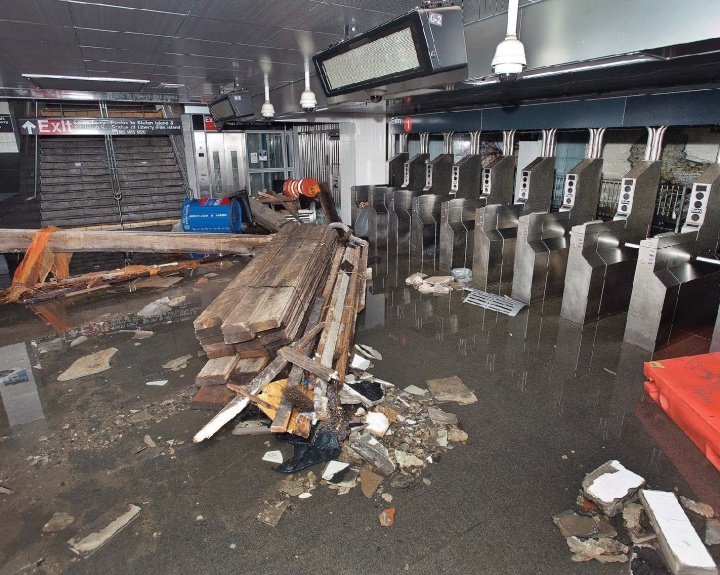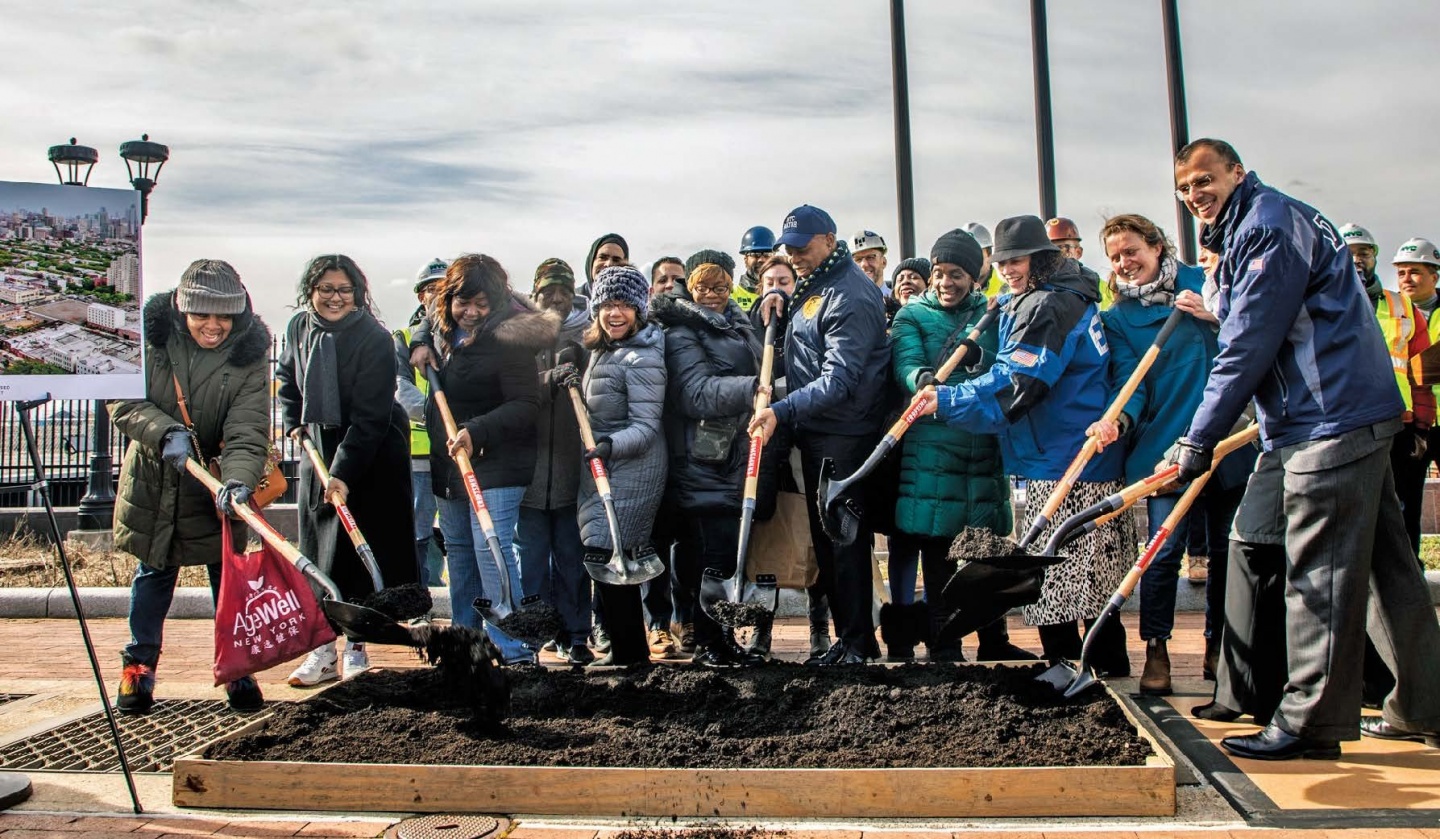Rohit T. Aggarwala ’93 is preparing New York City to meet the existential threat of a warming planet.
Columbia College | Columbia University in the City of New York
Rohit T. Aggarwala ’93 is preparing New York City to meet the existential threat of a warming planet.

Photographs by Jörg Meyer
For Rohit T. Aggarwala ’93, BUS’00, GSAS’02, these are not merely disturbing facts. Facing the threat of climate change is his mission and calling. He is New York City’s first chief climate officer, and, if there’s any remaining skepticism about the magnitude of Earth’s predicament, he could undoubtedly produce terabytes of evidence to make the case — record temperatures, sea level rise, displaced populations, epidemiological risks, the death of coral reefs and much more. Or he could simply point to an announcement most of us probably missed: “In late 2020 the National Climate Assessment officially recategorized New York City from the continental climate zone to the subtropical climate zone,” Aggarwala says. “In other words, you don’t live where you thought you lived.”
Acknowledging that reality, Mayor Eric Adams appointed Aggarwala to the newly created climate post soon after taking office in January 2022. The move signaled the heightened priority of addressing environmental threats and streamlined the city’s bureaucracy by uniting existing programs promoting sustainability, resilience, decarbonization and environmental justice. At the same time, Aggarwala was named commissioner of the city’s 5,700-employee, $4 billion Department of Environmental Protection (DEP), responsible for a broad portfolio: a billion-gallon daily water supply; an enormous sewer system; 19 reservoirs; wastewater treatment at 14 separate plants; hazardous materials remediation and environmental pollution of all kinds.
“It is evident to anyone who opens their eyes that we are in the midst of a climate crisis in this city and around the world,” Adams said at the press conference announcing Aggarwala’s appointment. “It’s time to think outside the box and determine how we can handle the crisis before it’s too late.”

Aggarwala with Marty Fatooh, an intergovernmental affairs manager at the Mayor’s Office of Climate & Environmental Justice.
Looming over Aggarwala’s sprawling mission is the urgent need to curb greenhouse gases, affirmed yet again by the international agreement at December’s COP28 conference in Dubai. “If you know you’re in the middle of a problem, the first thing you have to do is stop making the problem worse,” he says. This requires long-range strategic planning and near-term transformations in energy, transportation and other sectors.
The city’s goals are ambitious: reduce carbon emissions by 40 percent by 2030 and 80 percent by 2050, the target date for full carbon neutrality. To that end, New York is banking heavily on two programs: congestion pricing for vehicular traffic entering Manhattan, and Local Law 97, which requires building owners to meet benchmark emissions standards.
The most immediate threat, however, is water — from the sky above, and from the rivers, bays, harbor and ocean coastline that have long nourished the region’s life and prosperity. Already, torrential rainstorms have periodically overwhelmed the sewer systems and caused flash floods. “Everything the science tells us is that it’s going to get worse before it stabilizes,” Aggarwala said in a CNBC interview last October. “Climate is changing faster than our infrastructure can keep up.”
The arrival of Hurricane Sandy in October 2012 was an obvious turning point. Thanks to an unlucky convergence of weather and tidal patterns, which caused an already destructive Category 1 hurricane to become a superstorm, Sandy unleashed a mighty 14-foot storm surge into New York Harbor, inundating the subway system, major tunnels and hundreds of city blocks. Power outages crippled the city, darkening all of Manhattan below 30th Street; with typical New York cheek, the area was immediately dubbed SoPo, as in South of Power. But the toll was no joking matter: The hurricane killed 44 residents in the five boroughs; damaged some 69,000 residential units; and caused an estimated $19 billion in economic losses. The cost of repairing and rebuilding was even higher. Much of the U.S. East Coast and several Caribbean islands were also hard hit.

DAVID SHANKBONE / WIKIPEDIA COMMONS

Hurricane Sandy devastated New York City on October 29–30, 2012. Top, flooding on Avenue C at East 6th Street; bottom, seawater filled the South Ferry subway station.
METROPOLITAN TRANSPORTATION AUTHORITY / PATRICK CASHIN
Accordingly, he has foregrounded coastal resilience as a top priority, addressing storm surges and rising sea levels, as well as tidal flooding, extreme rainfall, underground drainage, sewer capacity and the protection of critical infrastructure such as electrical substations and pumping stations. The task is extraordinarily complex and expensive, requiring city, state and federal participation. “The overall cost of coastal protections for all of New York Harbor is estimated by the U.S. Army Corps of Engineers to be at least $52 billion,” Aggarwala says.
Especially critical are a pair of long-term plans targeting the Manhattan shoreline from East 25th Street southward along the East River to the Battery, and then northward along the Hudson to Chambers Street. Long in the works, these efforts have proven to be enormously challenging undertakings that entail constructing a system of berms, seawalls and gates, and creating new riverside parks and demolishing existing ones, to the dismay of some local residents.
One project that has worked out well so far can be found in Far Rockaway, Queens, where the Army Corps built an elevated oceanfront berm that is integrated with the beach. It has survived nicely through several storms, including the especially severe one at high tide two days before Christmas 2022. “That part of the Rockaways actually got no flooding,” Aggarwala notes.

Aggarwala surveys the Hunts Point Wastewater Resource Recovery Facility in the Bronx; DEP is investing $368 million to replace aging infrastructure with more efficient, sustainable and reliable systems.
COURTESY NYC DEPARTMENT OF ENVIRONMENTAL PROTECTION
“That project is many years late, and I think it typifies some of the problems that we face,” he says. “Radioactive material was found at one of the sites, and you have a dozen different agencies involved.” What’s more, while the Army Corps was building the seawall, the city and DEP had to step in to avoid what they foresaw as a major drainage problem. “If you build a seawall to keep water out, you’re also going to keep stormwater in. And so, we’ve had to redesign it, but do it to their standards, and that itself has led to about two years of delays.
“It’s fascinating to me,” he adds, “that it is really the nuts and bolts of how you move these projects forward that makes the difference, far more than designing them or even raising the money.”
No stranger to the labyrinthine ways of municipal government — he was a top environmental advisor to Mayor Michael Bloomberg from 2006 to 2010 — Aggarwala brings an impressive background to his latest challenge.
Born and raised in White Plains, N.Y., he attended public schools except for a stint at St. Stephen’s School in Rome, when his father, Narinder Aggarwala JRN’65, SIPA’71, was posted there with the U.N.’s World Food Programme. During his time at the College, Rohit, known to all as Rit (rhymes with “wit”), majored in American history, wrote a regular column for Spectator, served as president of the College Democrats and graduated magna cum laude.
He went on to earn a master’s in history from Queen’s College in Kingston, Ontario, returning to Columbia to pursue an M.B.A. in finance and eventually a Ph.D. in American history. His dissertation explored New York’s eclipse of Philadelphia as the nation’s leading city in the early 19th century; famed urban historian Kenneth Jackson, who had mentored him as an undergrad, was his thesis advisor.
Aggarwala was a consultant at McKinsey & Co. for several years before joining Bloomberg’s City Hall team; there, he established himself as an expert in urban environmental issues, quarterbacking the PlaNYC long-term blueprint for sustainable development. Among other professional ventures between mayors, he founded the environmental grantmaking program at Bloomberg Philanthropies, headed the board of directors of the global C40 Cities Climate Leadership Group and helped launch a Google technology startup, Sidewalk Labs, focusing on urban systems innovation.
Through it all, Aggarwala has maintained his serious involvement in Columbia life. As a grad student he taught Contemporary Civilization from 2000 to 2002 and was elected to the University Senate. He was one of two students on the presidential search committee that led to the appointment of Lee C. Bollinger and has served on the Columbia College Alumni Association’s Board of Directors. For the past 10 years he has taught at SIPA, leading a class on the politics and policy of urban sustainability. It’s billed as a policy course, he says, “but it’s really a history class in disguise.” (He teaches a similar course at Cornell Tech each fall.) He is proud that his class selected him for SIPA’s Outstanding Teacher Award last year. Aggarwala knows how great teaching can inspire a student: “I first heard about climate change in Wally Broecker [’53, GSAS’58]’s class on the design and maintenance of a habitable planet,” he says.
Aggarwala lives on the Upper East Side with his wife, Dr. Elizabeth Robilotti ’99, PH’03, and their three young daughters. Something of a renaissance man, he has registered three patents (one granted, two pending) for environmental processes. He also runs marathons and continues to publish historical research; his latest topic: NYC’s role as a British administrative center in the 18th century.

Last March, Aggarwala joined Mayor Eric Adams and others for the groundbreaking of a $1.6 billion infrastructure project that will prevent up to 12 million gallons of sewer overflow from polluting the Gowanus Canal.
COURTESY NYC DEPARTMENT OF ENVIRONMENTAL PROTECTION
Aggarwala has no byline on his most influential publication — PlaNYC: Getting Sustainability Done, the strategic plan for a greener New York — yet he was an indispensable manager of the team that produced it. First issued in 2007 by the Bloomberg administration, the plan was updated and reissued in April 2023. Both congestion pricing and the Local Law 97 mandates were proposed in the original report. And both plans have generated controversy.
Under Local Law 97, stiff fines await the owners of buildings larger than 25,000 square feet who fail to meet emission standards. (By way of comparison, consider that Hamilton Hall is 87,639 square feet.) So far, the pace of conversion has exceeded expectations. Nonetheless, the high cost of compliance is onerous for many non-luxury building owners and low- and middle-income tenants, whose rents will likely rise. The city recently allowed landlords to apply for relaxation of the schedule, provoking howls from some environmental activists.
Meanwhile, congestion pricing — which Bloomberg News has called “the most important transportation experiment in decades” — is set to begin as early as May. Based on pioneering theoretical work by Columbia economist William Vickrey GSAS’47, the plan calls for a $15 fee for cars entering Manhattan between the Battery and 60th Street during business hours, with the aim of unclogging traffic, reducing air pollution and subsidizing mass transit.
The prospect of paying a steep fee on top of the high cost of tolls, gas and parking is not sitting well with many drivers, especially those from New Jersey, whose governor has filed suit. Staten Island’s borough president calls the fees “highway robbery” — literally. Others point out that mass transit is difficult or inconvenient from many places in the metropolitan area, or for people who have no practical choice. The greener options of cycling or walking might be swell for people with a short commute; try doing it every day, in every kind of weather, from Bensonhurst or Throgs Neck.
Aggarwala is not inclined to budge.
“The U.S. Department of Energy sees the implementation of Local Law 97 as a matter of national importance,” he says. “And if New York City implements congestion pricing and gets it right, I think we’re going to have a number of other cities around the country embrace it before too long.” Furthermore, he notes, “When cities around the world have implemented congestion pricing, whether it’s London or Singapore, Stockholm or Milan, it actually leads those people who have better alternatives to use the alternatives, which makes the driving easier for the people who have no alternatives.”
Happily, greening New York is not all about struggle and change. There is a program in place to plant a million trees, providing shade and beautifying neighborhoods while removing tons of carbon dioxide — who could oppose that? And there are some delightful nuggets, such as the city’s Bluebelt initiative. “We designed lakes and wetlands, engineered them and connected them to storm sewers so that they could become excess holding capacity for massive amounts of rainwater,” Aggarwala notes. Thirty have been developed so far, mostly on Staten Island and in southeast Queens; he envisions a citywide network. Similarly, some 12,000 much smaller rainwater gardens have been installed to direct sewer runoff to gardening use.
Another project is what he calls “cloudburst” designs; public spaces such as neighborhood basketball courts are lowered by around three feet, so they can serve as holding areas for excess water. “That gives you some steps and nice stadium seating around the side,” Aggarwala says. “People love that.”
In the end, all of these projects, large and small, will be judged by whether they contribute to the survival of New York as a thriving city. We are in the critical decade of the climate fight, Aggarwala believes. This is no time to relent or back off. “I have three kids,” he says. “Giving up is not an option.”
Former CCT editor Jamie Katz ’72, BUS’80 has held senior editorial positions at People, Vibe and Latina magazines and has contributed regularly to Smithsonian Magazine. His most recent CCT piece was the Online Exclusive “Jim Gardner ’70: The Toast of Philadelphia.”

Published three times a year by Columbia College for alumni, students, faculty, parents and friends.
Columbia Alumni Center
622 W. 113th St., MC 4530, 6th Fl.
New York, NY 10025
212-851-7852
cct@columbia.edu

Columbia Alumni Center
622 W. 113th St., MC 4530, 4th Fl.
New York, NY 10025
212-851-7488
ccalumni@columbia.edu